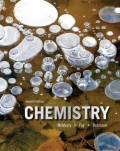
Concept explainers
To determine:
Type of compound.
Answer to Problem 7.1P
- Nonpolar covalent
- Ionic
- Ionic
- Nonpolar covalent
Explanation of Solution
Recall that the nature of the compound will depend on the electronegativity differences between the species involved. If the electronegativity difference between the atoms is large enough, it will be ionic, that is, this is not a shared bond, rather a donation/acceptance of electron. This is called ionic bonding since the cation and anion will interact via electrostatic forces. These are CsBr, which is metal and nonmetal bond, and FeBr3, which is once again metal with nonmetal. These will typically form ionic bonding.
Covalent bonding forced when species are not that different in electronegativity. They are bonded due to the sharing of electrons. There might be uneven sharing of electrons, and there could be a polar molecule formation, or there could be even sharing of electrons, which causes a pure nonpolar covalent compound.
Methane, CH4, is a nonpolar covalent compound, due to its symmetry. Then comes SiCl4, which is similar to methane, in which the hydrogen atoms are both bonded to a central atom. It is also nonpolar covalent.
The nature of polar and ionic bonding depends mainly on the electronegativity difference of the species.
Want to see more full solutions like this?
Chapter 7 Solutions
EBK CHEMISTRY
 ChemistryChemistryISBN:9781305957404Author:Steven S. Zumdahl, Susan A. Zumdahl, Donald J. DeCostePublisher:Cengage Learning
ChemistryChemistryISBN:9781305957404Author:Steven S. Zumdahl, Susan A. Zumdahl, Donald J. DeCostePublisher:Cengage Learning ChemistryChemistryISBN:9781259911156Author:Raymond Chang Dr., Jason Overby ProfessorPublisher:McGraw-Hill Education
ChemistryChemistryISBN:9781259911156Author:Raymond Chang Dr., Jason Overby ProfessorPublisher:McGraw-Hill Education Principles of Instrumental AnalysisChemistryISBN:9781305577213Author:Douglas A. Skoog, F. James Holler, Stanley R. CrouchPublisher:Cengage Learning
Principles of Instrumental AnalysisChemistryISBN:9781305577213Author:Douglas A. Skoog, F. James Holler, Stanley R. CrouchPublisher:Cengage Learning Organic ChemistryChemistryISBN:9780078021558Author:Janice Gorzynski Smith Dr.Publisher:McGraw-Hill Education
Organic ChemistryChemistryISBN:9780078021558Author:Janice Gorzynski Smith Dr.Publisher:McGraw-Hill Education Chemistry: Principles and ReactionsChemistryISBN:9781305079373Author:William L. Masterton, Cecile N. HurleyPublisher:Cengage Learning
Chemistry: Principles and ReactionsChemistryISBN:9781305079373Author:William L. Masterton, Cecile N. HurleyPublisher:Cengage Learning Elementary Principles of Chemical Processes, Bind...ChemistryISBN:9781118431221Author:Richard M. Felder, Ronald W. Rousseau, Lisa G. BullardPublisher:WILEY
Elementary Principles of Chemical Processes, Bind...ChemistryISBN:9781118431221Author:Richard M. Felder, Ronald W. Rousseau, Lisa G. BullardPublisher:WILEY





